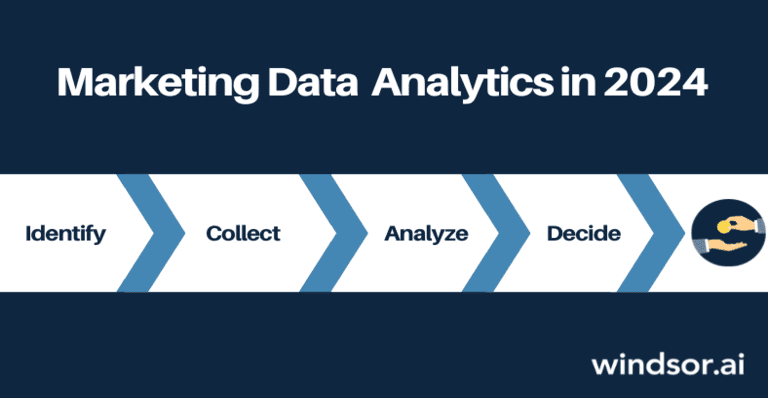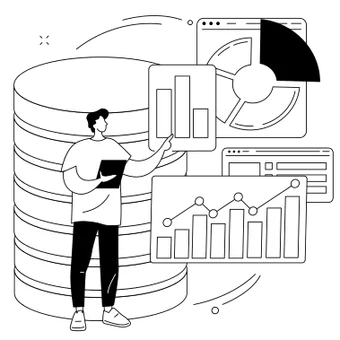What is marketing data analytics and why do you need it?

Without marketing data analytics, assessing the success of advertising efforts becomes a blind process, leading to inefficiency and potential negative outcomes.
Some companies can experience success without analytics, attributing it to luck. However, understanding the reasons behind successful campaigns or identifying issues in case of failure becomes elusive without proper analytics.
So what is marketing data analytics?
In this article:
- What is marketing data analytics?
- Types of Data in Digital Marketing
- The Role of Data Analytics in Marketing
- Data Analytics’s Advantages for Marketing
- Marketing Data Analytics Challenges in 2024
- Key Steps in Marketing Data Analytics
- Useful tools for marketing data analytics
- How do you start using marketing analytics?
- Summary
- FAQ
What is marketing data analytics?
Marketing data analytics involves analyzing marketing data to extract actionable insights. This encompasses identifying key marketing metrics, collecting reliable data, tracking metrics over time, and leveraging results to enhance future strategies.
It integrates people, tools, and technology to achieve marketing goals.
Types of Data in Digital Marketing
Digital marketing generates diverse data types from various sources, providing valuable insights for monitoring current strategies and planning future campaigns:
- Campaign Data: Information detailing the performance of marketing campaigns, including metrics such as conversion rates, cost per acquisition, and click-through rates.
- Social Media Data: Metrics associated with social media engagements, such as conversion rates, cost per acquisition, and click-through rates.
- Website Analytics: This includes data related to website traffic, user behavior, and conversion funnels, derived from tools like GA4.
- Customer Data: This encompasses demographic information, browsing behavior, past purchases, and engagement metrics.
The Role of Data Analytics in Marketing
Organizations use marketing data analytics in various ways:
- Tracking customer interactions to enhance products, adjusting features and pricing based on customer needs.
- Understanding customer trends to tailor marketing mix, segment customers, and create targeted campaigns.
- Improving customer support by identifying areas of difficulty and developing training or self-service options.
- Tracking competitors and understanding strengths and weaknesses to gain a competitive edge.
- Understanding the effectiveness of messages and media in reaching and converting customers, leading to targeted campaigns.
- Tracking competitors and understanding strengths and weaknesses to gain a competitive edge.
- Utilizing predictive analytics to forecast future outcomes, optimizing budgeting, and enhancing chances of success through targeted campaigns.
Data Analytics’s Advantages for Marketing
In today’s business landscape, data analytics offers numerous advantages:
Informed Decision-Making
Enables objective decision-making based on facts and data rather than guesswork.
Time and Money Savings
Identifying effective marketing strategies reduces time on future projects and prevents wasteful spending on unproductive efforts.
Increased Revenue
Empowers understanding of customer needs, facilitating targeted messaging and timely engagement, ultimately boosting revenue.
Personalization and Customization
Data analytics enables the creation of personalized experiences for customers.
Marketers can deliver tailored content, recommendations, and offers based on individual preferences, enhancing the overall customer experience.
Marketing Data Analytics Challenges in 2024
While a powerful tool, establishing an effective analytics process poses challenges:
Data Silos
Data silos occur when different departments collect and analyze data separately, leading to duplicated, incomplete, and inconsistent datasets.
Data silos frequently occur when different departments use incompatible data management systems.
Volume and Variety of Data
Managing the diverse and complex marketing data landscape can be overwhelming.
Lack of information and expertise
Many organizations require additional skills for effective data analytics, spanning statistical analysis, data visualization, technical expertise, and a deep understanding of customers and products.
Limited availability of resources
Businesses can lack the necessary resources, including budget and staff, for proper utilization of data analytics.
Difficult to Identify Meaningful Analytics
Identifying and tracking relevant metrics can be challenging, requiring a strategic approach aligned with overall objectives.
Despite challenges, marketing data analytics proves instrumental in enhancing marketing strategy. Windsor.ai specializing in data automation and analytics, offers valuable assistance in this realm.
Key Steps in Marketing Data Analytics
The marketing analytics process involves continuous cycles of measuring, analyzing, and improving:
1. Selecting Appropriate Metrics
Choose metrics aligned with marketing strategy, such as website performance, digital ads metrics, social media metrics, email marketing metrics, marketing team performance metrics, lead generation metrics, and customer metrics.
2. Collect Marketing Data
Gather data from various sources, including websites, CRM, and marketing automation tools.
Many businesses find it challenging and time-consuming to gather data from various sources. Moreover, the task does not end there, as the data needs to be consolidated, compared, and undergo other transformations. To streamline this process, the most effective option is to automate it using Windsor.ai.
This platform offers a convenient solution for smoothly exporting and combining your marketing data from 75+ sources such as GA4, Hubspot, ad applications, and more. You can establish connections between these sources and destinations like Looker Studio, Power BI, Google Sheets, Excel, and Tableau.
3. Exploring Metrics through Analysis and Visualization
Utilize dashboards and reports to visualize metrics, gaining correlations and insights into marketing team health and performance.
4. Identifying Actions and Changes with the Potential for Improvement
Determine actions and changes likely to yield improvement, addressing low performance and replicating successful strategies.

Try Windsor.ai today
Access all your data from your favorite sources in one place.
Get started for free with a 30 - day trial.
Useful tools for marketing data analytics
Marketing analytics constitutes a multifaceted process. However, with the right tools and technology, you can do it more easily.
The right tools not only streamline tasks but also enhance efficiency, allowing for a better understanding of data, task automation, audience segmentation, real-time and more accurate insights, and improved collaboration. Let’s explore some of the most popular and beneficial marketing analytics tools, categorized for your convenience:
- Website Analytics Tools: These tools capture and monitor various website metrics, including total pageviews, unique visitors, and time on site.
- Business Intelligence (BI) and Data Visualization Tools: BI tools facilitate the extraction of raw data from multiple sources, transforming and loading it into dashboards or other visualizations. Integrating a web scraper API can automate data collection from websites, ensuring BI platforms have access to fresh, real-time insights for more accurate and data-driven decision-making.
- Cohort Analysis Tools: Aimed at observing how metrics evolve over time, contributing to improved customer retention and accurate lifetime value estimates.
- Marketing Automation Tools: Software automates and measures marketing tasks and workflows, including lead management, email marketing, campaign management, and analytics.
- Social Media Analytics Tools: These tools track diverse social media metrics, such as engagement, reach, and impressions.
- Search Engine Optimization (SEO) Tools: Assist marketers in enhancing website ranking in search engine results pages (SERPs), offering features like keyword research and link-building.
While the above list provides a snapshot of marketing analytics tools, the challenge lies in choosing the right ones. Start by defining your needs, conduct research on potential options, compare features, prioritize ease of use, and review them against price points.
How do you start using marketing analytics?
So, if you’re aiming to become highly proficient and acquire analytical superpowers, the key is to determine how to initiate this journey. The use of a marketing maturity assessment tool helps in understanding where your organization currently stands in terms of data usage and facilitates progress toward the more advanced stages of marketing analytics.
Reflecting on our maturity tiers, it’s crucial to ensure a strong foundation at the base levels, one that can be expanded upon. This involves establishing robust systems for data collection and analysis. Begin by consolidating all essential data from marketing campaigns, website analytics, and other crucial platforms into a unified source.
For those with coding skills or a willingness to delegate to the BI team, consider exploring data warehouses like Google BigQuery and Snowflake. Alternatively, if coding isn’t your forte (or you’re not keen on waiting for BI team responses), delve into marketing data hubs like Windsor.ai
The choice between these options depends on your capabilities and business model, as each can lay the groundwork for advancing to the more advanced tiers of marketing analytics maturity. It’s essential to recognize that while marketing analytics software isn’t the ultimate solution for effective analysis, it can serve as the fundamental stepping stone needed to kickstart your journey.
Summary
The significance of marketing data analytics in facilitating informed business decisions cannot be overstated. With a clear grasp of what marketing data analytics entails and how to leverage it, you can enhance decision-making processes, ultimately contributing to heightened revenue.
Although there can be hurdles in the collection and analysis of marketing data, Windsor.ai provides a seamless solution to overcome these challenges.
Our free trial lets you do just that. Head over to Windsor.ai right now!
- 75+ data sources
- Integrations with data visualization platforms like Looker Studio, Power BI, Big Query, SnowFlake, PostgreSQL, MySQL, Google Sheets, Excel, Azure MS SQL, Tableau, Python, Amazon S3, Azure Blob Storage, etc.
- Forever Free Plan
- SOC 2 Type 2 certified, supports single sign on and multi factor authentication
- Capterra Review score average 4.8 out of 5
- All connectors available on all plans: No premium connectors

Try Windsor.ai today
Access all your data from your favorite sources in one place.
Get started for free with a 30 - day trial.
FAQ
What are marketing data analytics models?
A model for marketing data analytics is a structure used to analyze and interpret marketing data, aiming to extract insights for informed decision-making. This process encompasses the collection, organization, and analysis of data to comprehend customer behavior, identify trends, and discern preferences. This empowers businesses to refine their marketing strategies and enhance overall performance.
What is the normal marketing analytics process?
We can describe a conventional marketing analytics process in four stages:
- What happened?
- Why did it happen?
- What will happen next?
- What actions can I take?
How Organizations Use Marketing Analytics?
Marketing analytics data plays a crucial role in guiding decisions across various aspects, including ad expenditure, product enhancements, branding, and beyond. To attain a comprehensive 360-degree perspective of your campaigns and ensure sound decision-making, it’s imperative to aggregate data from diverse sources, encompassing both online and offline channels.
How can data analytics improve marketing strategy in 2024?
While businesses may function without a well-defined marketing strategy and analytics, implementing them adds consistency.
Analytics provides insights into current performance and guides necessary improvements, ensuring a continual focus on producing better results.
Read also:
Power BI for Marketing Analytics in 2024
How does data-driven attribution work?
What is data-driven marketing?
Why is Marketing Reporting Important?
Why ETL tools are important for marketers


